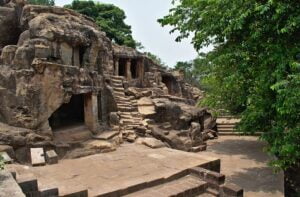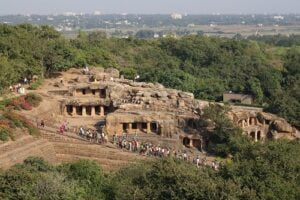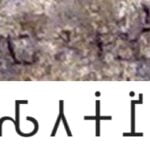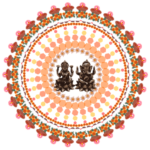The Hathigumpha inscription is a seventeen-line inscription in the Prakrit language incised in Brahmi script. Due to natural causes like rains, dust, and being written in a very obscure Prakrit, this inscription made it difficult to read. However, the Hathigumpha inscription holds historical records that shed light on the reign and accomplishment of Kharavela.
Location:

One can visit the Hathigumpha Inscription or Elephant Cave Inscription of Kharavela at Udayagiri, Odisha. It is near about 5 km west of Bhubaneswar International Airport. Among many rock-cut caves, the Hathigumpha cave was found on the southern face of Udayagiri hills. The inscription was found partly in front and partly on the ceiling of the cave.
Discovery:

It is assumed that the Hathigumpha inscription was made between the 2nd century BCE and 1st century CE. In 1825, A. Sterling published about this inscription in Asiatic Researches XV. After some time, in 1837 James Princep published an eye-copy prepared by Kittoe followed by a trace by Alexander Cunningham in 1877. In 1880 R.L. Mitra published a modified version in his Antiquities of Orissa. Later, Indraji declared that the Hathigumpha inscription was related to King Kharavela. However, the cast impression, interpretation, and translation had many errors.
Brief description of Hathigumpha inscription:

The Hatigumpha inscription, consisting of seventeen lines has been composed in Prakrit language and Brahmi script. The first 8 lines are visible at the front of Hathigumha cave on the overhanging brow. The remaining 9 lines appear on the cavern’s roof in a sloping shape. The inscription covers about 15 feet by 5.5 feet on the stone surface.

According to a handwriting analysis, three different ancient scribes likely worked together in this inscription. Some of the lines like 1-6 lines are well preserved while the other lines of the inscription are partially damaged. However, the line 7 record is mostly gone. These lines were from the period of King Kharavela’s 6th and 7th year of reign. Lines 8 through 15 have large gaps due to natural damage and are prone to misreading. Natural processes like rains, dripping water, dust, and such reasons corrupted some of the Brahmi script.
Some facts mentioned in the Hathigumpha inscription:
According to the palaeographical analysis, the Hathigumpha inscription cannot be earlier than the 2nd century BCE or later than the 1st century BCE. Furthermore, some historian suggests that the inscription belongs to the second half of the 1st century BCE or possibly in the first decade of that century.
Several scholars translated this inscription. Jayaswas and Banerji published the translation in Epigraphia Indica Volume 20 with alternate readings by the other scholars.

| L1 & L2: | The first lines confirm that this inscription is a Jaina inscription and Jainism was well established in Kalinga. These lines also mention the ancient Chedi dynasty of Greater India. Writing, coinage, account, administration, and procedures are those 5 skills learned by Prince Kharavela. |
| L3, L4 & L5: | In manhood (which comes after the age of 25) Khravela obtains the imperial coronation. In the first year of his reign, he repaired gates, walls, and city buildings at the state’s expense. Also, he restored all gardens at a cost of thiry-five-hundred-thousands. In the 2nd year of his reign, he fought his first war with Satakamni with lots of elephants, and infantry chariots. He throws the city of Musikas into consternation.
|
| L6: | The 6th line indicates another big water project and tax exemptions. According to Barua, the water project extended a previously dug canal. This canal brought water to Kalinga Capital. Due to some damage to the lines, this portion can also be read in different ways. Some suggest that kharvela is definitely not from the 3rd century BCE. |
| L7 & L8: | These lines suggest that a child was born to his wife and King Kharavela. In the opinion of Sircar, this information is doubtful since Karavela’s wife from the Vajiragraha family is unlikely. There was a mention of Greek rule and a claim of their retreat to Mathura. Some scholars suggest that the Greek rule is about Demetrios of Bactria, though it most likely indicates another Indo-Greek ruler. |
| L9: | Due to loss in the inscription this portion is read by different scholars differently. According to Barua, King Kharavela performed a yajna ritual in the context of Brahmin. Barua also read that Kharavela respected Brahmins and Jain monks equally. On the other hand, Sircar stated that the word ‘Varna’ was incorrectly translated as caste. He also stated that the Jain king would not be expected to perform the Rajasuya sacrifice. |
| L10, L11 & L12: | Another war and victory mentioned in these lines. However, Sircar doubted that this part was incorrectly translated. Translation of these lines also claims that the king got victory over Magadha and set up an image of ‘The Jina of Kalinga’ which was previously taken by King Nanda. |
| L13: | King Kharavela set up a school of masons (artisans and architects) and built excellent towers with curved towers with carved interiors. He also exempted masons from land revenue. |
| L14, L15, L16 & L17: | Besides the large gaps in the inscription due to natural damages, scholars stated that Kharavela gave donations to monks and preachers. He also set up a council of advisors with ascetics and sages from many parts of ancient India. Finally, the last line tells that the Great conqueror, King Kharavela respected all religions and stated some praises of the king. |
You can also visit Other Inscriptions in our page.
Significance of Hathigumpha inscription:
The main source of information about the Jain Kalinga ruler Kharavela is the Hathigumpha inscription. Despite natural damages and large gaps in the inscription, it states the year-by-year achievements of Kharavela. Besides the disagreement between scholars in interpreting the Hathigumpha inscription, there were major public infrastructure projects. The Inscription also stated about the donations to the monks and Brahmins.

In addition, the inscription mentioned a war against Satavahana king Satakarni. Walter Spink states that this mention is a key contributor to the misdating of many Buddhist monuments in central India. First, it is said that the Hathigumpha inscription belonged to the 3rd and 2nd century BCE and then Satakarni was treated as a contemporary of Kharavela.
In addition, it mentioned that Kharavela extended a water canal to the Kalinga capital which was built by a Nanda king in the first place. There is also much confusion with the timeline of Nanda kings in this mention.
According to Salomon, the translation and interpretations vary widely by different scholars and it is impossible to conclude in a single standard version. However, from the Hatigumpha inscription, we came to know about the religious values, public projects, military expeditions, society, and culture of King Kharavela, a king in the eastern region of ancient India.


Pingback: The Remarkable Satavahana Dynasty: A Glimpse into the Past - India Insights